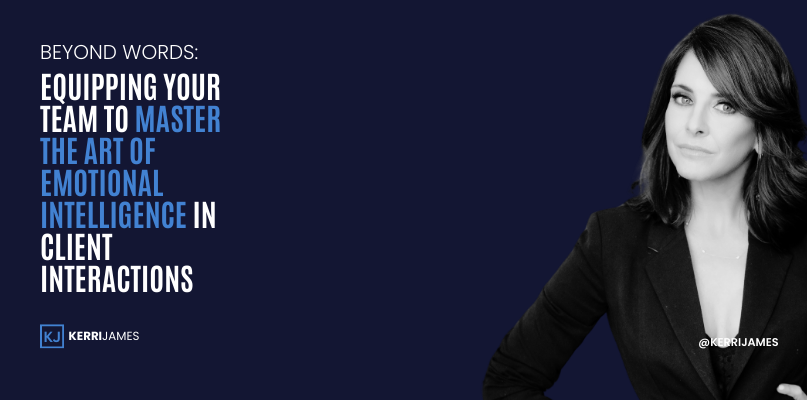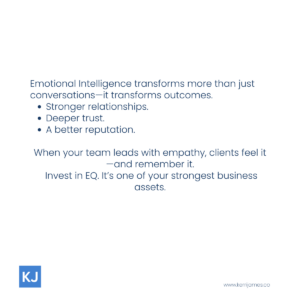I remember a conversation with a mentor early in my career. He shared a story about a client meeting where the client seemed disengaged, even hostile. He’d meticulously prepared his presentation, outlining every detail of his proposal, but nothing seemed to connect. Later, he learned that the client had just received some difficult personal news before the meeting. My mentor’s takeaway? It wasn’t about the presentation; it was about the person. That conversation profoundly shaped my understanding of client interactions. It highlighted the critical importance of emotional intelligence – the ability to recognize, understand, and manage our own emotions and the emotions of others. In client-facing roles, particularly in fields like law where emotions often run high, emotional intelligence isn’t just a “nice-to-have” – it’s a fundamental skill that can make or break a case, a relationship, and ultimately, a business.
Building a team that excels in emotional intelligence requires more than just hiring naturally empathetic individuals. It necessitates a deliberate and ongoing training process that equips your team with the tools and techniques to navigate the complex landscape of human emotions. It’s about fostering a culture where emotional awareness is valued, practiced, and continuously refined.
The Foundation: Understanding the Importance of Emotional Cues
Before embarking on any specific emotional intelligence training strategies, it’s vital to establish a clear understanding of why emotional intelligence is crucial, particularly in client-facing roles. Client interactions are rarely just about transactions; they are inherently human, layered with complex emotions, subtle anxieties, and unspoken needs. Emotions play a pivotal role in how people communicate, react, and make decisions, and recognizing these emotional cues can significantly impact the success of client interactions. Emotional intelligence allows team members to better understand the emotional states of clients and respond in a way that fosters connection, trust, and collaboration.
Understanding emotional cues is not about manipulating clients or gaining control over them; it’s about creating an environment of respect and empathy. When clients feel that they are being heard and understood, they are more likely to open up, share their true concerns, and engage in honest communication. This atmosphere of trust makes it easier to identify solutions and resolve issues, which, in turn, can lead to stronger, more lasting relationships. Furthermore, when clients perceive a team member as emotionally intelligent, they are more likely to feel valued and supported, which translates into higher client satisfaction and loyalty.
Emphasizing the importance of emotional intelligence in client interactions creates a solid foundation for training. It encourages team members to adopt a mindset that goes beyond a mere transactional view of relationships. Instead, they come to understand the deeper, emotional layers that shape client behavior. This shift in perspective allows them to navigate conversations with greater care, responding appropriately to the unspoken messages their clients may be communicating. Whether it’s a hesitant tone or a subtle expression of frustration, being able to recognize and act on these cues makes the difference between a successful interaction and a missed opportunity. Training should aim to help team members see their role as not just service providers but as emotional allies who play an integral part in creating positive, lasting client experiences.
Active Listening: Hearing Beyond the Words
Active listening is one of the most fundamental aspects of emotional intelligence and serves as the bedrock of meaningful communication. It involves more than just hearing the words a client says—it’s about fully concentrating on their message, both verbal and non-verbal. Effective active listening requires focus, without distractions or preconceived judgments clouding the message. Team members need to listen intently not only to the content of what’s being said but also to the tone, body language, and emotions behind the words. This helps build a deeper understanding of the client’s perspective.
During training, the importance of active listening should be emphasized through practical exercises. Role-playing is an effective method, where team members take turns practicing how to listen with full attention. They should focus on maintaining eye contact, nodding, and other non-verbal cues that demonstrate they are engaged and actively processing what the client is saying. This helps develop the necessary skills to reflect back what they hear, ensuring that the client’s message is correctly understood. Additionally, summarizing key points and asking clarifying questions is a powerful technique to confirm the message and demonstrate engagement.
Active listening also involves putting aside one’s own thoughts and responses during the conversation, which can be challenging, especially in high-pressure situations. However, it’s crucial for avoiding misunderstandings and fostering a deeper connection with clients. When team members listen attentively, clients feel validated and respected, which increases the likelihood of a productive and collaborative relationship. Furthermore, it enables the team member to better decode the client’s emotional state, which is key to responding appropriately and offering solutions that truly meet the client’s needs.
Decoding Non-Verbal Cues: The Silent Language of Emotion
Non-verbal cues, such as body language, facial expressions, and eye contact, often reveal more about a client’s emotions than words alone. Small changes in posture or a pause before responding can indicate feelings like frustration or anxiety. Recognizing these cues helps team members respond with empathy, improving the quality of client interactions.
Training team members to decode non-verbal cues involves developing their awareness of these signals and understanding their context. For example, crossed arms may signal defensiveness, while relaxed posture suggests openness. Using visual aids and discussing cultural or personal differences ensures accurate interpretation, avoiding miscommunications.
Team members should also observe non-verbal cues alongside verbal communication. A client who says everything is fine but shows tension or avoids eye contact may have unspoken concerns. By recognizing these cues in real-time, team members can address underlying emotions and respond more effectively.
Empathy: Stepping into the Client’s Shoes
Empathy is a vital skill for client-facing roles, allowing team members to understand a client’s emotions and respond with genuine care. It goes beyond acknowledging feelings—it’s about deeply understanding their emotional state and showing compassion. When team members demonstrate empathy, clients feel valued, which builds trust and strengthens relationships.
Training should encourage team members to reflect on their own emotions to better relate to clients’ experiences. By imagining how they would feel in the client’s shoes, they can communicate more emotionally and connect on a human level. Phrases like, “I can imagine how difficult this must be” show empathy and understanding.
Empathy also involves recognizing subtle cues when clients don’t explicitly express their emotions. Training should help team members identify these signs and respond with warmth and concern, easing tension and creating a safe space for clients to open up. This approach leads to more tailored solutions that truly address client needs.
Responding with Emotional Intelligence: Choosing the Right Words and Actions
Once emotional cues are identified, the next step is responding with emotional intelligence by using the right words, tone, and body language. This can greatly impact the outcome, especially in high-emotion situations. Training should focus on verbal and non-verbal communication that conveys empathy, support, and respect.
Encourage team members to stay calm and solution-oriented when dealing with upset clients. Role-playing exercises can help them practice responding to different emotions, such as anger or sadness, in a way that diffuses tension and fosters productive dialogue. Patience and composure are essential in maintaining control of the conversation.
Emotional intelligence also involves using positive body language, such as mirroring the client’s posture or expressions to build rapport. Verbal responses should show empathy, like saying, “I can see why that’s upsetting.” These responses demonstrate that the team member is emotionally present and ready to address the client’s needs.
Managing Your Own Emotions: Maintaining Composure Under Pressure Using Emotional Intelligence
Client interactions can be emotionally charged, especially with difficult clients. It’s crucial for team members to manage their emotions to keep interactions productive. Developing emotional self-regulation strategies helps team members stay calm, composed, and empathetic in challenging situations.
Training in emotional regulation should introduce techniques such as deep breathing, mindfulness, and reframing negative thoughts. Deep breathing and mindfulness help team members stay calm and present during stressful moments, reducing emotional overwhelm. Reframing negative thoughts shifts focus from frustration to problem-solving, promoting a clearer mindset. Encourage short breaks when needed to prevent burnout and maintain composure in tough conversations.
It’s also important to foster an environment where team members feel supported. Encourage open communication about challenging interactions, and create opportunities for debriefing after difficult client engagements. This process allows team members to reflect on their emotional responses, learn from the experience, and develop better coping strategies for future interactions.
Building a Culture of Emotional Intelligence: Ongoing Development and Support
Emotional intelligence is a skill that requires continuous development and reinforcement. To foster a culture of emotional intelligence within the team, actively provide ongoing learning opportunities, feedback, and growth.
Regular feedback sessions provide a platform for team members to share experiences, best practices, and receive constructive criticism, fostering a growth mindset. Access to resources like books, articles, and online courses can further deepen their understanding of emotional intelligence in client interactions.
Mentorship and peer support are also key in reinforcing emotional intelligence. Experienced team members can offer guidance and strategies for handling emotional situations. Creating a supportive learning environment helps the team continuously build emotional intelligence, ensuring it becomes a natural part of their client interactions.
The Power of Questions: Unveiling Underlying Emotions Using Emotional Intelligence
Skilled questioning is a powerful way to uncover the emotions behind a client’s behavior. Clients may express frustration or dissatisfaction, but open-ended questions like “Can you tell me more about that?” create space for deeper conversations and a clearer understanding of their true concerns.
Training your team to go beyond surface-level issues helps reveal emotional triggers. For example, asking “What specifically is causing you the most frustration?” can uncover the root cause of a concern, allowing for more targeted and empathetic responses.
Thoughtful questions also build trust by showing clients they are truly heard and understood. Encouraging your team to be patient and attentive during these conversations leads to more open communication and stronger client relationships. With practice, these skills can greatly enhance the emotional intelligence of your team.
Tailoring Communication Styles: Adapting to Individual Needs
Every client communicates differently, so it’s important for your team to adapt their style to meet individual emotional and communication needs. Some clients prefer a direct approach, while others respond better to a softer, more thoughtful tone.
For example, assertive clients may appreciate quick, decisive answers, whereas reserved clients might need more time and a gentler approach. Some may enjoy humor to ease tension, while others prefer a serious, professional tone. Recognizing these differences helps create a more comfortable and productive environment.
Train your team to observe cues like tone, body language, and pacing to identify each client’s preferred communication style. Encourage flexibility so they can shift approaches when needed—for instance, switching to a more empathetic tone if a client seems uncomfortable.
By tailoring communication, your team can reduce misunderstandings, build trust, and strengthen client relationships. Over time, this skill becomes second nature, improving both client satisfaction and long-term loyalty.
Dealing with Difficult Clients: Strategies for De-escalation and Resolution
Dealing with difficult clients is a natural part of client-facing roles, and it’s crucial to equip your team with the skills to handle these situations professionally. With the right strategies, even tense interactions can be de-escalated and resolved effectively.
One of the most important techniques in managing difficult clients is acknowledging their emotions. When a client is upset, the first step is to validate their feelings by saying things like, “I can understand why you’d be frustrated” or “I see how this situation is upsetting.” This shows the client that you are actively listening and that their feelings are being taken seriously. Validating emotions helps reduce tension and allows for a more productive conversation.
Next, it’s crucial to offer solutions. Instead of simply agreeing with the client’s frustration, your team should focus on actionable steps that can address their concerns. Ask open-ended questions like, “What would you like to see happen?” to engage the client in finding a resolution. Offering potential solutions helps shift the conversation from a focus on emotions to a more constructive, solution-oriented discussion.
Role-playing challenging scenarios can help your team practice these de-escalation techniques in a safe and supportive environment. By simulating difficult interactions, team members can learn how to remain calm and focused, even when faced with an upset client. Emphasize the importance of staying composed and using a calm, respectful tone, regardless of the client’s behavior. Practicing these strategies will help your team develop confidence in handling difficult situations and ultimately lead to better client outcomes and stronger client relationships.
Measuring the Impact of Emotional Intelligence Training
To ensure that emotional intelligence training is having the desired impact, it’s important to implement methods for measuring its effectiveness. Tracking client feedback, monitoring case outcomes, and assessing team morale are all valuable metrics that can provide insights into how well the training is influencing client interactions and team performance.
Client satisfaction surveys are one of the most direct ways to measure the success of emotional intelligence training. Ask clients about their experiences, focusing on how they felt during interactions and whether they felt understood and respected. This helps gather both qualitative and quantitative data on the impact of the training.
Look for patterns in the feedback, such as increased client satisfaction or fewer complaints. These trends can highlight how emotional intelligence is improving team-client interactions.
Assessing team morale is key. When employees feel confident in managing emotions and communicating well, job satisfaction usually improves. Regular check-ins and performance reviews help track how emotional intelligence is being applied.
Ongoing support and feedback keep your team engaged in developing these skills. Monitoring these metrics allows you to adjust training to better support both team performance and client satisfaction.
Final words 
In today’s competitive landscape, providing exceptional client service is no longer a luxury; it’s a necessity. By investing in emotional intelligence training for your team, you are investing in the future of your business. Equip your team to go beyond meeting client needs—build lasting relationships rooted in trust, empathy, and emotional intelligence. By shifting from transactional to meaningful interactions, you foster loyalty, drive growth, and set your brand apart. Emotional intelligence isn’t just about closing deals—it’s about creating real connections and lasting impact.













